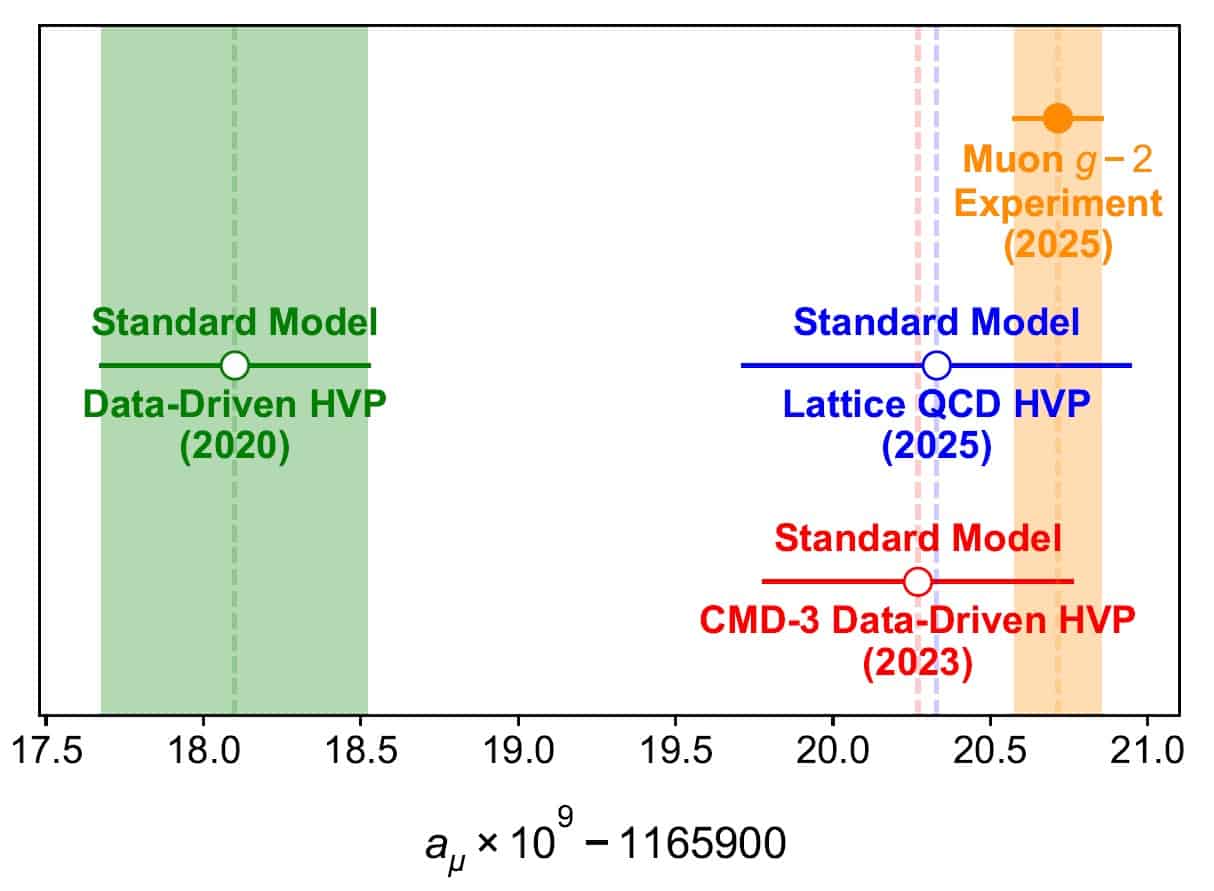In 2018, the Muon g-2 Experiment at Fermilab near Chicago, set out to measure the muon’s anomalous magnetic moment to a precision of 140 parts per billion (ppb). This component of the muon’s magnetic moment is the result of several subtle quantum effects and is also known as the muon g-2 – which reflects how the gyromagnetic ratio of the muon deviates from the simple value of two.
After six years of producing, storing, and measuring more than a trillion muons, the collaboration released its long-anticipated final result in June, achieving an unprecedented precision of 127 ppb. This landmark measurement not only solidifies confidence in the experimental value of muon g-2 but also sets a new benchmark as the most precise accelerator-based measurement of a fundamental particle to date.
Studies of the muon g-2 have served as a rigorous test of the Standard Model – physicist’s leading theory describing known particles and forces – for much of the last century. Theoretically, the muon’s anomalous magnetic moment can be predicted from the Standard Model to a similar precision as the experiment. For decades, a persistent discrepancy between prediction and measurement hinted at the possibility of new physics, with experimental results favouring a higher value than the theory. Such a difference, if confirmed, could point to phenomena not accounted for in the Standard Model – potentially explaining unresolved mysteries like the existence of dark matter.
However, extraordinary claims require extraordinary scrutiny. To address the experimental side, Fermilab launched the Muon g-2 Experiment. On the theoretical side, the Muon g-2 Theory Initiative was established as a global collaboration of theorists working to refine the Standard Model prediction using state-of-the-art methods, techniques, and input data.
Problematic contribution
One of the most problematic contributions to the theoretical value is the hadronic vacuum polarization (HVP), historically determined using experimental data as input to complex calculations. While the Theory Initiative has improved these methods, progress has remained limited due to discrepancies in the available experimental data. Crucially, a recent input from the CMD-3 Experiment diverged significantly from previous results, suggesting a larger HVP contribution (see figure below). This, in turn, yields a Standard Model prediction that aligns with the new Fermilab measurement – apparently eliminating the discrepancy and, with it, any evidence of new physics.

Despite years of investigation, the origin of the CMD-3 tension remains unknown. Its result stands in contrast to a vast catalogue of earlier data from multiple experiments over decades. As a result, the traditional, data-driven approach to estimating the HVP is deemed currently unable to produce a reliable estimate .
Thanks to the efforts of the Theory Initiative, however, the HVP can now also be calculated using lattice QCD (quantum chromodynamics) simulations on supercomputers, reaching a precision comparable to that of the data-driven methods. Multiple independent lattice QCD groups have arrived at consistent values, which also agree with the Fermilab measurement, indicating no discrepancy and thus no sign of new physics. This computational feat, once considered out of reach, marks a major breakthrough. Yet, the tension remains unresolved: Why do lattice QCD and CMD-3 agree, while both conflict with decades of experimental data?
No physics beyond the Standard Model
Given the improved control in lattice QCD, the Theory Initiative has also recently updated its recommended Standard Model prediction with the HVP fully based on lattice results. The resulting value agrees with the Fermilab measurement and currently implies no evidence for physics beyond the Standard Model. However, the Initiative has emphasized that this is far from conclusive. Future predictions are intended to incorporate data-driven estimates again – once the inconsistencies in the experimental input are resolved.
The field now faces two possibilities. One is that the CMD-3 result and lattice QCD are correct. In this case, there is no new physics – but an impressive validation of the Standard Model. The other scenario is that new experimental HVP input data align with the older results, supporting a smaller HVP contribution. This would reintroduce the discrepancy with the Fermilab result, reviving the exciting possibility of new physics. In either case, the inconsistencies between CMD-3, lattice QCD, and the existing data must be explained.
So, is there new physics or not? We know there must be. The Standard Model cannot not explain dark matter, the accelerating expansion of the universe, the absence of antimatter, or the quantum nature of gravity. Precision tests like muon g-2 offer a window into this unknown. That window has not closed – for now it’s propped open.
Where we’ll be in five years is uncertain. The Muon g-2 Theory Initiative will continue to refine predictions and resolve open questions. For now, one thing is clear: the Muon g-2 Experiment at Fermilab has delivered an historic achievement and its legacy will continue to contribute to our understanding of fundamental physics for decades to come.
The post Muon g-2 achieves record precision, but theoretical tensions remain appeared first on Physics World.

